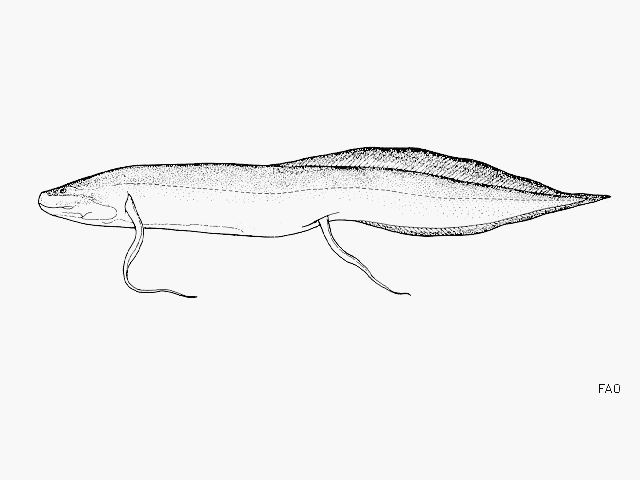| Protopteridae (African lungfishes) |
| 200 cm TL (male/unsexed); max.weight: 17 kg |
|
demersal; freshwater; depth range 0 - 60 m |
| Africa: subspecies Protopterus aethiopicus aethiopicus distributed in Nile basin and lakes Albert, Edward, Victoria, Nabugabo, Tanganyika, Kyoga and No (Ref. 3498), also in Lake Turkana (Ref. 52331). Subspecies P. a. congicus distributed in Congo basin, from Upper Lualaba to Kinshasa (Ref. 3498). Subspecies P. a. mesmaekersi distributed in Lower Congo River basin (Ref. 3498). |
|
Smooth, slimy, cylindrical body with deeply embedded scales (Ref. 28714). Tail pointed and confluent with the long dorsal and anal fins; dorsal fin originating at an equal distance from eye and vent, or nearer to the latter; pectoral and pelvic fins slender and filamentous (Ref. 34290). Perpendicular from dorsal fin origin closer to posterior than to anterior limbs (Bailey 1994). 55-70 scales in a longitudinal series from immediately behind head to above vent; 40-50 scales around body (Ref. 4903, 45485). 37-40 pairs of ribs (Ref. 4903). Dentition consisting of upper and lower tooth plates in the form of sharp cutting ridges (Ref. 34290). Young fish with true external gills, but usually absent in specimens above 15 cm TL (Ref. 34290). Dark slate-grey above, yellowish-grey or pinkish below, often with numerous dark spots or flecks on fins and body; some specimens bright yellow ventrally; sensory canals on head and body outlined in black (Ref. 34290). |
| Adults inhabit river and lake fringes, swamps and floodplains (Ref. 28714). In the Lake Victoria basin found in open lakes and marginal swamps, while in the Lake Tanganyika basin only found near rivers and deltas (Ref. 4967). Juveniles occur in matted roots of papyrus (Ref. 34291). Adults able to survive in streams and swamps that are completely dry for long periods of the year, withstanding desiccation on floodplains by aestivating in cocoons until the next rains, breathing air by a small passage leading to the outside (Ref. 45484). Obligate air-breather (Ref. 126274) under laboratory conditions (Ref. 34291), but under certain conditions lungfish in the wild may not be obligate air-breathers and the use of aerial respiration may be a function of ecological as well as physiological factors (Ref. 58531). Mature individuals breed during the flood season (Ref. 28714). One or several females spawn in burrows which are dug and cleaned by the male, who later guards the eggs and the young. Principal diet of adults and sub-adults consists of mollusks, but small fishes and insects are also eaten in small quantities; young individuals less than 35 cm TL feed almost exclusively on insects (Ref. 34291). |
|
Least Concern (LC); Date assessed: 02 March 2018 Ref. (130435)
|
| harmless |
Source and more info: www.fishbase.org. For personal, classroom, and other internal use only. Not for publication.

